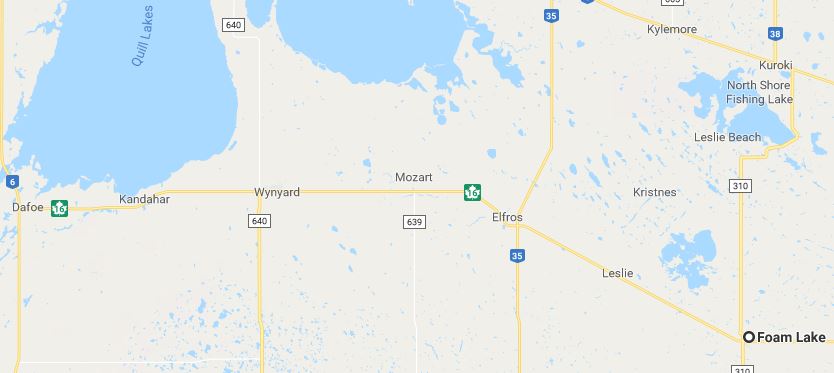Province of Saskatchewan: Saskatchewan is located in western Canada, between Alberta and Manitoba. In the southern half of the province, a largely flat and featureless landscape is underlain by soft sedimentary rock such as shale, and Ice Age sediments such as mixed gravel, sand, silt and clay. Ice Age floods 10,000 years ago carved the spectacular, wide, steep-sided, and flat-bottomed Qu’Appelle Valley that crosses the region. In these former grasslands that are now productive grain-growing regions, summer is hot and dry, while winter is very cold and snowy. The region has suffered through occasional very dry multi-year droughts. In this region, Icelandic settlement was focused in the farmland around the east-central Saskatchewan towns of Kandahar, Wynyard, Mozart, Elros, Leslie, and Foam Lake, including the Lakes Settlement (Vatnabyggð) District. To the south and close to the Manitoba border, Icelanders settled in Churchbridge and Tantallon, and the Districts of Thingvalla, Logberg, and Holar. H. Thorleifson.
Settlement in the early 20th century
At the beginning of the 20th century, a turning point came in the lives of many Icelanders in N. Dakota and various Icelandic settlements in Manitoba. The second generation began to look around for new settlements because it had become very crowded at home, no more land for young farmers. In the United States there was almost no land to be had and in Manitoba little or no respectable land was left untouched. People turned their attention to western Canada, the plains west of Manitoba were almost the only area that farmers could think of in the whole continent.
Almost all land in Þ(Th)ingvellir and Lögberg was occupied, as was Hóla. But west of Foam Lake, much of the land was unoccupied, all the way to the town of Dafoe and its immediate vicinity.

Two Icelandic settlements were created here, one of the largest Icelandic colonies in North America and another much smaller one. It was south and west of the village of Gerald and a few settled in the Spy Hill village. Icelanders were few in the beginning and some actually moved from there to Wynyard some years later. The new colony was called the Lake Settlement (Vatnabyggð) and was over 70 km long (43.5 miles) and spread about 30 km (18.5 miles). It reached north and east from Foam Lake to Fishing Lake. A post office called Kristnes was opened in this area. The C.P.R railway reached Foam Lake but the continuation was certain, it would continue to be laid west of the new settlement, and that was crucial because all transport to and from the settlement was by train at that time. When you look at the map, you can clearly see how small villages were built by the railway in a very organized way. Foam Lake is the easternmost, then Leslie, then Elfros, Mozart, Wynyard, Kandahar and finally Dafoe. Clearly, the gap between the villages is almost exactly the same, but it was no coincidence. The locomotive needed water at certain intervals and this determined the location of the villages. It can be said that the railroad companies in Canada shaped the structure in Saskatchewan and Alberta, not the whims of the settlers.
The Icelandic settlement stretched far south of Foam Lake and to the east and south a post office called Mount Hecla was opened, while to the west, southwest of Leslie, the post office was called Hólar. West of Elfros and all the way to Wynyard, the settlement did not go as far south, but then expanded at Wynyard. Lands governed the settlement west of Wynyard to Dafoe, but in that area the settlement did not reach as far south as Leslie. The post offices west of Leslie were in the villages and named after them. All settlers e. g. around the Kristnes Post Office had the same address, the letters to them were addressed to Kristnes P. O. (Post Office) and there the farmers picked up their mail. It is worth noting that when farmers wrote letters and sent them, they addressed them to the Kristnes P.O. and with the date.
Many people have wondered in writings and speeches why Icelanders chose this area because it is nowhere near the best arable land in the Canadian plain. An Icelandic settler settled in the Foam Lake settlement in 1898 and was soon hired as the Canadian Government’s agent for much of the land west of Foam Lake. He, together with the government agents in Manitoba, encouraged Icelanders to choose countries where mixed farming could be practiced, i. e. both animals and grain farming. Emphasis was also placed on Icelandic settlements, that Icelanders would take many lands together and form entire settlements. Icelanders did not have to say this specifically because they usually did it everywhere. The agent at Foam Lake knew of a vast and good agricultural area west and south of Dafoe but did not go far with it. There is also a theory that in those days mixed farming was considered a more secure industry, because if wet or dry periods hindered the normal growth of grain, the profits changed less for those who also had a dairy farm.
The land in the Lakes Settlement (Vatnabyggð) is very similar to what characterizes the Hóla Settlement much further south and like that in Þingvalla-Lögberg Settlement. This choice was also to prove successful for farmers, especially during the difficult drought of the 1930s.
English version by Thor Group.
